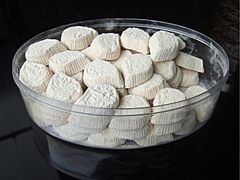Kue satu facts for kids

White-colored kue satu
|
|
| Alternative names | Kue koya |
|---|---|
| Type | Kue kering (traditional cookie) |
| Course | Snack |
| Place of origin | Indonesia |
| Region or state | Java |
| Serving temperature | Room temperature |
| Main ingredients | Mung beans, powdered sugar, vanilla essence |
| Variations | kue koya kacang tanah (peanut) |
Kue satu is a yummy traditional cookie from Indonesia. People in West Java and Jakarta call it Kue satu. In Central and East Java, it's known as kue koya. This cookie is made from sweet, white mung bean powder. It's famous for crumbling easily when you take a bite!
You can find Kue satu all over Java, an island in Indonesia. It's a special treat often served during big celebrations. These include Lebaran (a Muslim holiday), Natal (Christmas), and Imlek. Many believe these cookies came from traditional dry cookies made by Chinese Peranakan people long ago.
Contents
How to Make Kue Satu
Making Kue satu or Kue koya is quite simple. You only need four main things: mung beans, powdered sugar, vanilla extract, and a little water.
Preparing the Mung Beans
First, the mung beans are gently toasted without oil. You toast them until their skins start to crack open. After toasting, the skins are carefully removed from the beans.
Mixing and Baking
Next, the peeled mung beans are ground into a fine powder. This can be done using a traditional mortar and pestle or a modern food processor. Then, this mung bean powder is mixed with powdered sugar, vanilla extract, and a small amount of water. This mixture forms a soft dough.
The dough is then pressed into small cookie molds. These molds give the cookies their shape. Finally, the shaped cookies are baked in an oven at about 150°C (300°F).
Drying and Storing
After baking, the cookies are not quite ready. They need to air dry and sun dry for several hours. This step helps them become perfectly crisp. Once completely dry, Kue satu cookies are stored in airtight containers. This keeps them fresh and delicious for a long time.
Different Kinds of Kue Satu
The most common Kue koya is made from mung beans. This gives the cookie its classic white color.
Another interesting type is called kue koya kacang tanah. Instead of mung beans, this version uses ground peanuts. Because of the peanuts, this Kue koya has a lovely brown color. Both types are tasty and popular!

